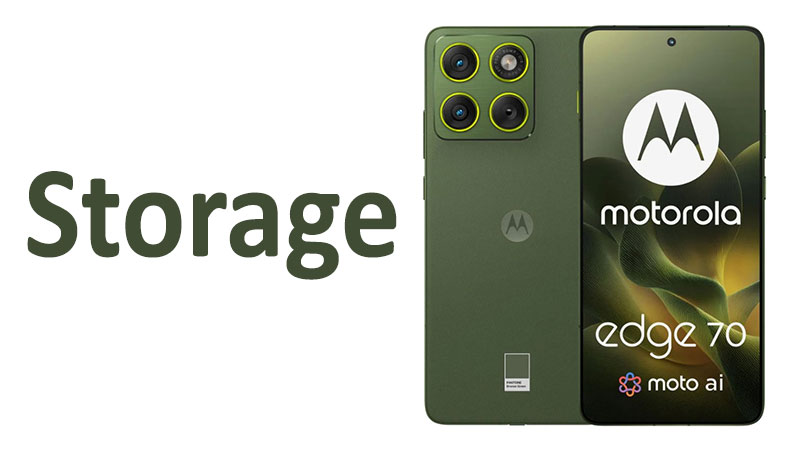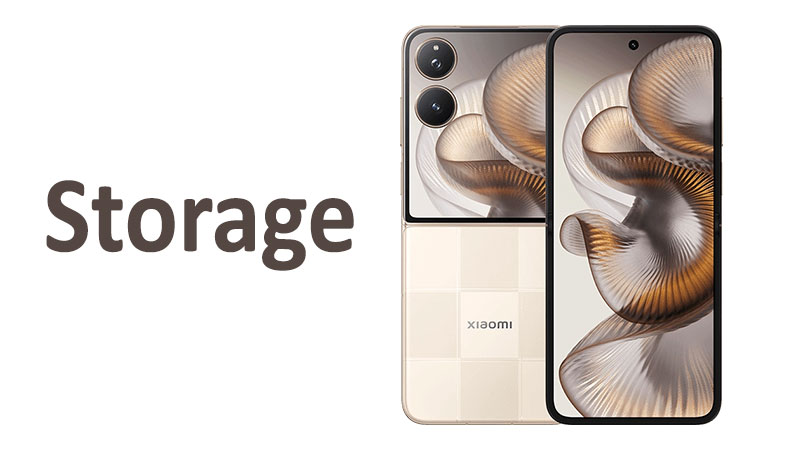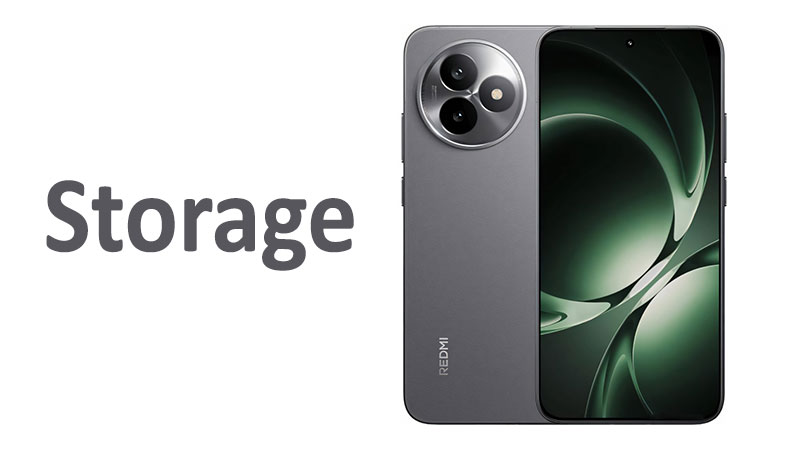The Motorola Edge 70 Storage system is a critical component of its performance profile. Understanding its capacity and technology is essential for buyers. This detailed guide analyzes the internal memory options thoroughly. We examine how the specific storage type impacts daily use. Buyers need to choose wisely as there is no expansion option. Ultimately, this review helps readers make an informed purchasing decision.
Understanding Motorola Edge 70 Storage Capacity
The Motorola Edge 70 offers users two distinct internal storage tiers. These capacities are standard for premium modern smartphones. Customers can select either the 256GB or the 512GB configuration. This selection must support all future data needs. This is because the Edge 70 does not include a microSD card slot. The chosen capacity is permanent for the device’s lifespan.
256GB: The Standard Tier
The 256GB option serves as the base model capacity. This amount is sufficient for most average smartphone users. It accommodates extensive photo libraries and numerous applications. Users who primarily stream media will find this adequate. They do not store many high-resolution videos locally. The 256GB tier keeps the purchase price lower. This provides a balance between storage space and cost efficiency. It is a solid choice for general everyday use.
However, content consumption is always increasing. App sizes continue to expand yearly. High-fidelity audio and games demand more space. Users must factor in the operating system’s space requirement. The actual usable space is always slightly less than 256GB. Buyers should monitor their storage usage carefully over time.
512GB: The Power User Option
The 512GB configuration targets users with demanding storage requirements. This tier provides double the capacity of the base model. It is perfect for professional photographers and mobile videographers. Recording many hours of 4K or 8K video consumes vast amounts of storage. This larger capacity supports that workload effortlessly. Serious mobile gamers who install many large titles will also benefit.
Choosing 512GB is a form of future-proofing. It allows the user to grow into the storage over several years. This eliminates the anxiety of constantly deleting files. It reduces reliance on cloud services for bulk media storage. Although the upfront cost is higher, the long-term convenience is significant. The 512GB option ensures optimal performance longevity. It accommodates any unexpected storage needs easily.
No Expansion: The Critical Limitation
The Motorola Edge 70 omits external storage expansion. It lacks a dedicated slot for a microSD card. This trend is common among high-end flagship phones. It is done to ensure the fastest possible performance. Internal UFS 3.1 memory is much faster than any consumer-grade microSD card.
However, this design choice means the storage capacity is fixed. Users must choose wisely at the point of purchase. They cannot increase space later if their needs change. External hard drives and cloud storage become the only offloading options. This limitation makes the 512GB model very attractive for anyone unsure of their needs. It prevents potential bottlenecks down the road.
The Technology Engine: Deep Dive into UFS 3.1
Storage capacity is only half of the performance equation. The type of storage technology is equally important. The Motorola Edge 70 uses UFS 3.1 flash memory exclusively. This is a high-speed standard in mobile technology. It is a key factor in the phone’s overall speed and responsiveness.
What UFS 3.1 Means for Speed
UFS stands for Universal Flash Storage. It is the modern protocol for smartphone memory. UFS 3.1 is significantly faster than previous generations. It greatly improves both reading and writing data speeds. This enhanced speed affects nearly every user interaction. Fast storage ensures a smooth and instantaneous user experience. It removes bottlenecks that slow down the processor.
The faster read speed ensures applications launch instantly. The write speed handles saving data quickly. UFS 3.1 provides sequential read speeds often exceeding 1,700 MB/s. Sequential write speeds commonly surpass 1,200 MB/s. These figures illustrate the sheer throughput capability. For large data transfers, this speed is revolutionary.
Technical Features: Write Booster and Sleep Notify
UFS 3.1 introduced several important technological enhancements. Two features stand out for their impact on performance. These are the Write Booster and the Sleep Notify features.
The Write Booster is arguably the most impactful addition. It significantly accelerates peak write performance. It utilizes a dynamically sized, high-speed cache for incoming data. This is crucial for tasks that involve large, immediate data saves. For example, saving long 4K video clips relies heavily on this feature. It ensures the writing process does not interrupt the continuous recording.
The Sleep Notify feature focuses on power efficiency. It allows the phone to transition the storage memory to a lower power state faster. This happens when the memory is not actively in use. This power management improves battery life slightly. It contributes to the Edge 70’s overall energy optimization. UFS 3.1 is therefore fast, reliable, and reasonably efficient.
Real-World Performance Translation
The technical specifications of UFS 3.1 translate directly to tangible user benefits. The difference is immediately apparent when using the phone.
Application loading times are minimal. Apps stored in the memory open almost instantaneously upon tapping. Boot-up times for the operating system are dramatically reduced. The phone starts quickly when powered on. Large files, such as movies or game backups, transfer faster. Moving files between a PC and the phone is a quick process.
Furthermore, gaming benefits hugely from this speed. UFS 3.1 ensures low latency during gameplay. Texture data streams quickly, preventing lag or stutters. This is especially true in graphically demanding, open-world games. The speed ensures the overall system remains fluid and responsive.
Specialized Comparisons and Competitive Analysis
The Motorola Edge 70 positions itself as a competitive high-end device. Comparing its UFS 3.1 storage to competitors and predecessors is necessary. This shows where the Edge 70 excels and where it faces challenges.
UFS 3.1 vs. UFS 4.0: The Newer Standard
Some competitor flagship phones now use the even newer UFS 4.0 standard. UFS 4.0 offers a generational leap in speed. It boasts read and write speeds up to double that of UFS 3.1. This is due to its increased bandwidth per lane.
However, UFS 3.1 remains extremely fast for real-world tasks. The benefits of UFS 4.0 are often only noticeable in synthetic benchmarks. For daily tasks, the difference is negligible. The inclusion of UFS 3.1 allows the Edge 70 to achieve excellent performance. It likely allows Motorola to offer the phone at a more competitive price point. UFS 3.1 provides 90% of the practical speed of UFS 4.0.
UFS 3.1 vs. UFS 2.2: The Mid-Range Gap
Many devices in the upper mid-range market still use UFS 2.2 storage. The difference between UFS 3.1 and UFS 2.2 is substantial. UFS 3.1 offers at least a 50% increase in sequential read speed. It offers an even greater increase in random read/write performance.
The Motorola Edge 70 decisively wins this comparison. This faster storage type is what defines the “flagship” experience. A phone using UFS 2.2 will feel noticeably slower. App installs, updates, and large file operations are much quicker on the Edge 70. This speed differential justifies the Edge 70’s premium positioning.
Edge 70 Storage vs. Previous Motorola Models
Motorola has historically adopted high-speed storage in its flagship lines. The transition to UFS 3.1 in the Edge 70 represents refinement. Previous generations often used UFS 3.0. The jump from UFS 3.0 to UFS 3.1 primarily brings the Write Booster. This improves sustained performance under load.
Furthermore, the higher base capacity is an improvement. Starting at 256GB is more consumer-friendly than a 128GB base model. Motorola recognizes the increasing storage demands of modern apps. The Edge 70 offers a more optimized and generously sized storage configuration.
Storage Buyer’s Guide: Key Considerations
Choosing the right storage configuration is essential for satisfaction with the Motorola Edge 70. Buyers must accurately assess their usage profile. They should consider their long-term data habits.
User Profile Matching
Your daily habits should dictate the capacity you choose. Streamers and Light Users mostly consume content online. They rely on services like Netflix and Spotify. The 256GB model is usually an economical and sufficient choice for them.
Photographers and Videographers frequently capture high-resolution media. A single minute of 4K video is a large file size. The 512GB is non-negotiable for these users. It prevents workflow interruptions and constant data management.
Mobile Gamers and App Hoarders download many large applications. They need space for game updates and caches. The 512GB option provides the freedom to install and keep dozens of large games. It eliminates the need to constantly uninstall games.
Future-Proofing Your Investment
A smartphone is a long-term investment. The Edge 70 is designed to last several years. Storage needs will only increase over that time. Software updates and app installations grow larger every year. Choosing the 512GB model offers a significant safeguard. It ensures the phone remains highly usable and fast for its entire lifespan. The extra cost upfront is minimal when spread over two or three years of ownership.
Cloud Storage Dependency
Evaluate your reliance on cloud storage services. If you pay for services like Google Photos or iCloud, the 256GB model is more viable. You can offload old media files automatically. This effectively creates unlimited storage access. However, this method requires a continuous internet connection.
If your connectivity is often poor or if you prefer keeping all data local, choose 512GB. Local storage provides immediate access to all files at UFS 3.1 speeds. This is much faster than downloading files from the cloud. The convenience of local storage is a strong argument for the larger capacity.
The True Cost of Capacity
The price difference between 256GB and 512GB is a factor. Buyers should view this price difference as an investment. It is the cost of never having to worry about storage again. The alternative involves manually managing files and dealing with slow cloud uploads. For many, the peace of mind offered by 512GB is worth the premium.
Remember, the UFS 3.1 speed is identical across both capacities. You are paying for volume, not speed, when upgrading. Prioritize the 512GB option if you anticipate heavy media usage.
Pros and Cons of the Storage System
A balanced perspective requires outlining the clear advantages and disadvantages. The Edge 70 storage system is robust but has a major limitation.
Key Strengths (Pros)
The primary strength is the UFS 3.1 implementation. It provides exceptional speed and responsiveness. This makes the phone feel genuinely fast in all daily tasks. The generous 256GB base capacity is a significant advantage. It is more spacious than many competing entry-level flagships. The Write Booster feature ensures sustained high performance. This is critical for 4K video recording stability. The choice of 512GB provides excellent future-proofing. It accommodates the growing file sizes of modern applications and media. This technology ensures the storage does not become a system bottleneck.
Potential Weaknesses (Cons)
The major drawback is the lack of a microSD card slot. This eliminates the possibility of cost-effective, external storage expansion. The maximum capacity is limited to 512GB. Some competitors offer a 1TB option for extreme professionals. The UFS 3.1 standard is high-speed but not the absolute newest. Some rivals now incorporate the UFS 4.0 standard. This leaves a small performance gap compared to the fastest possible options.
Conclusion
The Motorola Edge 70 Storage solution is a highlight of the device’s performance. The decision to use high-speed UFS 3.1 memory ensures a fast, fluid user experience. This storage type is critical for the phone’s flagship status. It guarantees quick app loading, seamless multitasking, and robust video recording.
The buyer’s main decision rests between the 256GB and 512GB capacities. Both offer excellent speed. However, the lack of a microSD card slot necessitates careful planning. The 256GB model is great for standard users and budget-conscious buyers. The 512GB model provides essential peace of mind and long-term viability for power users. Ultimately, the Motorola Edge 70 provides a high-quality storage foundation. Selecting the right capacity ensures maximum satisfaction throughout the phone’s lifespan.
Frequently Asked Questions (FAQ)
1. Does the Motorola Edge 70 support a microSD card?
No, the Motorola Edge 70 does not include any slot for a microSD card. The internal storage is not expandable.
2. What storage technology does the Edge 70 use?
The phone uses the high-speed UFS 3.1 flash storage technology. This ensures very quick data reading and writing.
3. How fast is UFS 3.1 compared to older storage types?
UFS 3.1 is significantly faster than UFS 2.2. It improves app loading and file transfer speeds dramatically for users.
4. Is the 256GB capacity enough for 4K video recording?
The 256GB is acceptable for casual 4K recording. However, frequent or extended 4K videography requires the 512GB option.
5. What is the benefit of the UFS 3.1 Write Booster feature?
The Write Booster accelerates how quickly the phone can save data. This prevents slowdowns when recording high-resolution videos or downloading large files.



